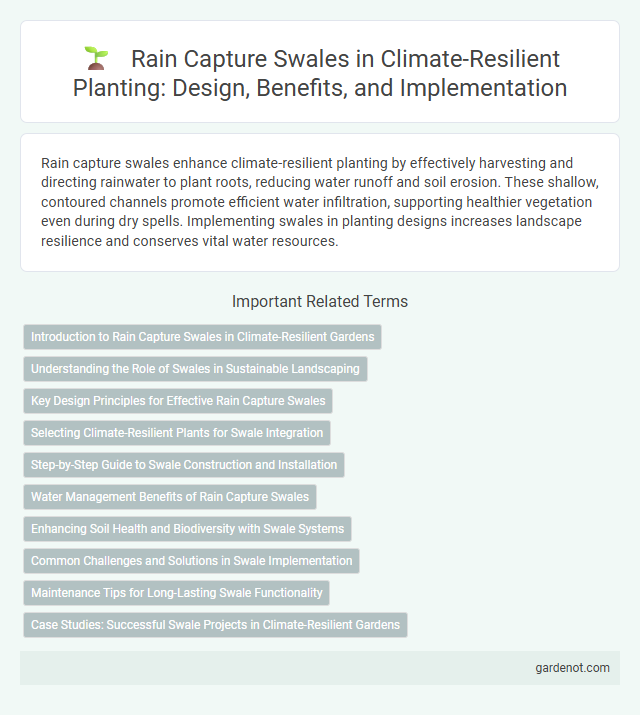Rain capture swales enhance climate-resilient planting by effectively harvesting and directing rainwater to plant roots, reducing water runoff and soil erosion. These shallow, contoured channels promote efficient water infiltration, supporting healthier vegetation even during dry spells. Implementing swales in planting designs increases landscape resilience and conserves vital water resources.
Introduction to Rain Capture Swales in Climate-Resilient Gardens
Rain capture swales are shallow, contour-following trenches designed to harvest and direct rainwater into gardens, enhancing soil moisture and reducing erosion. These landscape features effectively manage stormwater by slowing runoff, allowing water to infiltrate the soil and support plant growth during dry periods. Integrating rain capture swales into climate-resilient gardens improves water efficiency, aids in drought mitigation, and strengthens ecosystem health.
Understanding the Role of Swales in Sustainable Landscaping
Rain capture swales are shallow, vegetated channels designed to slow, capture, and infiltrate stormwater runoff, significantly reducing erosion and enhancing groundwater recharge. In sustainable landscaping, swales improve soil moisture retention, support native plant growth, and mitigate urban flooding by managing water on-site. Their strategic integration into climate-resilient planting schemes optimizes water efficiency while promoting ecosystem health and reducing reliance on conventional irrigation.
Key Design Principles for Effective Rain Capture Swales
Rain capture swales must be strategically designed with gentle slopes between 2-6% to ensure optimal water infiltration and prevent erosion. Incorporating permeable soils and native vegetation enhances water retention while supporting local ecosystems, promoting soil health and biodiversity. Proper spacing and sizing based on watershed area and rainfall intensity guarantee the swale's capacity to manage stormwater effectively and reduce runoff.
Selecting Climate-Resilient Plants for Swale Integration
Selecting climate-resilient plants for rain capture swales involves prioritizing native species with deep root systems that enhance water infiltration and soil stability. Drought-tolerant grasses, shrubs like Salvia and Ceanothus, and hardy perennials improve swale functionality by reducing erosion and maximizing water retention during fluctuating weather patterns. Integrating diverse vegetation supports ecosystem resilience while optimizing the swale's ability to manage stormwater in changing climates.
Step-by-Step Guide to Swale Construction and Installation
Constructing a rain capture swale begins with site assessment to identify contour lines for optimal water flow and retention. Excavate a shallow trench along the contour, ensuring a gentle gradient to slow runoff and maximize infiltration; use the extracted soil to build a berm on the downhill side. Finish by planting native, drought-tolerant vegetation along the swale and berm to stabilize the soil, enhance water absorption, and support climate-resilient landscaping.
Water Management Benefits of Rain Capture Swales
Rain capture swales effectively manage stormwater by directing runoff into the soil, enhancing groundwater recharge and reducing surface erosion. These landscape features improve soil moisture retention, promoting resilient plant growth during dry periods and minimizing on-site water loss. Integrating rain capture swales within climate-resilient planting systems supports sustainable water use while mitigating urban flooding risks.
Enhancing Soil Health and Biodiversity with Swale Systems
Rain capture swales improve soil health by slowing water runoff, promoting deep infiltration, and reducing erosion, which enhances nutrient retention and microbial activity. These swale systems create microhabitats that increase biodiversity by supporting a variety of plant species and beneficial insects. Effective implementation of swales contributes to resilient landscapes capable of withstanding climate variability while restoring ecological balance.
Common Challenges and Solutions in Swale Implementation
Rain capture swales often face common challenges such as soil erosion, poor water infiltration, and vegetation establishment difficulties. Solutions include designing swales with appropriate slopes to reduce runoff velocity, using mulch and native plants to stabilize soil, and incorporating organic matter to improve soil structure and moisture retention. Regular maintenance and monitoring address clogging and sediment accumulation, ensuring effective rainwater capture and long-term sustainability.
Maintenance Tips for Long-Lasting Swale Functionality
Regularly inspect rain capture swales for sediment buildup and clear debris to maintain optimal water infiltration. Mulching swale beds reduces erosion and supports soil moisture retention, enhancing plant health. Prune surrounding vegetation to prevent root intrusion and ensure unobstructed water flow through the swale system.
Case Studies: Successful Swale Projects in Climate-Resilient Gardens
Rain capture swales have proven effective in various climate-resilient garden projects by enhancing water retention and reducing soil erosion. Notable case studies include a California xeriscape garden where swales increased water infiltration by 40%, and an urban permaculture project in Australia that reduced irrigation needs by 60%. These successful implementations demonstrate swales' role in optimizing water management and supporting drought-resistant vegetation.
Rain capture swale Infographic

 gardenot.com
gardenot.com